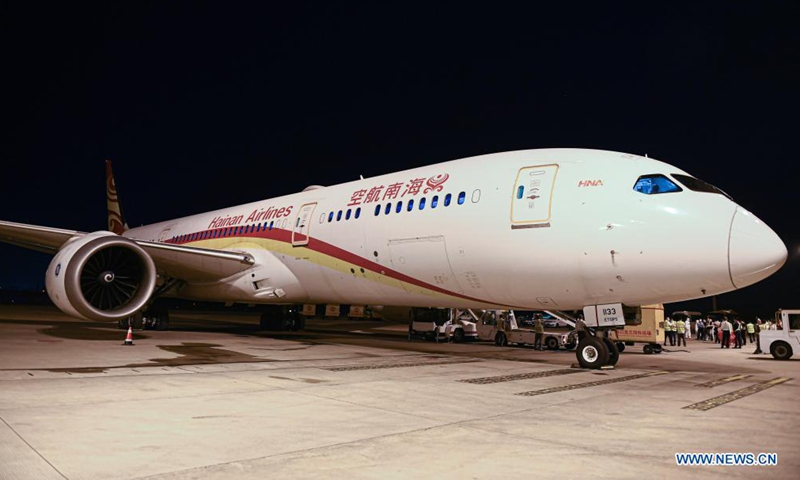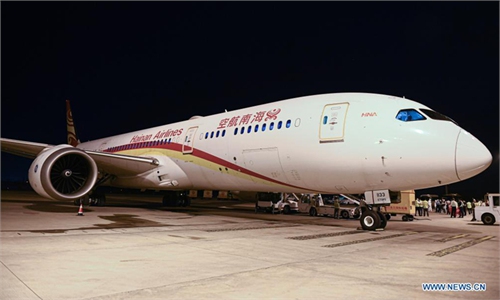Air cargo from China to North America hectic, facing capacity shortages and delays
Shortage of transport capacity, delays may loom soon

A cargo flight of Hainan Airlines is seen at Haikou Meilan International Airport in Haikou, south China's Hainan Province, March 26, 2021. China's southern tropical province of Hainan on Saturday launched a Haikou-Paris air freight route to serve international cargo transport of its free trade port. An outbound cargo flight carrying 35 tonnes of goods left Haikou for Paris on Saturday morning. Photo: Xinhua
Demand for air freight capacity from China to North America is rising as the global economy continues to recover from the coronavirus pandemic. But while major logistics providers launch new routes to deliver made-in-China products, limited transport capacity has pushed up rates, and there may be capacity shortages in the coming peak season.
FedEx on Monday announced the launch of four new intercontinental flights starting from China, offering Asia-Pacific businesses additional capacity of almost 1,400 tons every week, and enhanced service to major cities in North America, Asia and Europe, the company told the Global Times in a statement.
Following the launch of a new flight between Beijing and Anchorage, Alaska, FedEx has added three other flights connecting Guangzhou, South China's Guangdong Province, to North America and Europe.
"China continues its momentum in facilitating global economic recovery. The new flights not only increase the competitiveness of Chinese companies, but also propel international exports from this region.
"The added connectivity will play a key role in the resumption of business activities on a regional and global level," said Eddy Chan, senior vice president and president FedEx China.
China, as the world's manufacturing factory, has been churning out goods to keep the machines in plants running and supermarket shelves full all over the world.
In the first half of the year, China's total trade surged 27.1 percent year-on-year to reach 18.07 trillion yuan ($2.8 trillion), with imports increasing 25.9 percent year-on-year and exports growing 28.1 percent, according to data from the General Administration of Customs.
Robust exports pushed up demand for global cargo services, and also reflected the world's need for Chinese-made products, a person close to one of China's major airlines told the Global Times on Monday.
"Even if the Delta variant brought about COVID-19 flare-up in South China's Guangdong briefly, it did not have a huge impact on local factories."
Looking ahead, the peak season - which runs from October to December - may see freight capacity shortage, the person warned, as global transport capacity remains limited when work and operations in many other countries have not returned to normalcy.
Another logistics giant - SF International - told the Global Times on Monday that the hottest routes at present are from East China and South China to North America, and they usually requiring booking one week in advance.
"Recently, the rate for cargo from China to the US increased by 5 yuan per kilogram, but rates on routes from China to Europe and Southeast Asia did not change," the company said.
Both air and sea transport have been hot since the coronavirus outbreak, which have driven up transport costs by more than 30 percent last year compared with the pre-COVID level, an employee of a freight agency based in South China's Guangzhou told the Global Times on Monday.
The agency's main destination is India, and it usually carries about eight standard containers by air and 15-20 by sea each month.
Freight agencies have already warned of pending delays. A cross-border transport agent in Wuxi, East China's Jiangsu Province, said that it can't ensure the efficiency of air transport from Beijing to the US.
"There will be delays. Cargo usually passes through US customs at least eight working days after declaration," said the agent.
Within China, the latest COVID-19 outbreaks will make export declarations more complicated, and there could be more delays at airports, the agent said.

